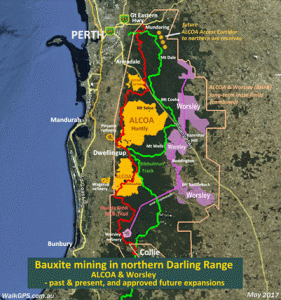Bauxite mining
Contents
The extent of strip-mining
Huge, long-term mining leases held by ALCOA and South32 (Worsley Alumina) cover a total area of almost 10,000 sq km, across most of the northern Darling Range State forests and drinking water catchment areas. They include a majority of the walk areas on WalkGPS. Strip-mining for bauxite first commenced at Jarrahdale in 1963 and major expansions of mining operations within the leases have since been approved by Government.
Additional leases in the north are also being explored by other companies, indicating a possibility that mining will eventually extend beyond the Alcoa and Worsley leases (including for nickel in Julimar Conservation Park). Mining company Rio Tinto has in 2022 applied for new mining exploration permits covering in total over 1000 sq km of the Darling Range from near Pinjarra to south of Collie.
Impact on bushwalking
Continuing expansions of the mining will increasingly impact on and greatly diminish quality bushwalking opportunities in the region in coming years. Bushwalking areas to be affected by the mining will in the future stretch from Bannister Hill in the south to at least as far north as the Ngangaguringguring Hill area. (See listing of at least 35 walks likely to be impacted.) Further south the expansion of the Willowdale operations into Lane Poole Reserve south of Dwellingup will soon reach within 200m of the Murray Campsite on the Bibbulmun Track; mining noise disturbance could potentially require re-location of the campsite. (Click for time lapse image of Willowdale operations for 1987-2016 period.)
Changing conservation priorities
Over the decades since the mining began, some new national parks have been declared in the Darling Range, but some forest conservation areas proposed in a 1994 plan were later greatly modified. These affected the proposed Gyngoorda Conservation Park around the Bannister Hill walk area and the proposed Gibbs Conservation Park around upper Dale River walk area. The changes evidently accommodate Worsley’s evolving mining expansion priorities. In the current Forest Management Plan produced by the Conservation & Parks Commission of W.A., the area of the proposed ‘reinstated’ Gyngoorda CP is 1350ha, less than 40% of the original planned area, and no longer protecting the whole of Bannister Hill; The total area of the proposed Gibbs CP has been reduced to 2280ha, also less than 40% of the original. (See WalkGPS video below.)
South32 (Worsley Alumina) mining expansion
The State’s Environmental Protection Authority (EPA) in February 2008 gave its approval for a major expansion of Worsley Alumina’s operations within their 2900 sq km lease. The EPA is an independent Authority with the broad objective of protecting the State’s environment. One of the EPA’s responsibilities to the community is to ensure that existing and planned recreational uses are not compromised. Worsley’s mining expansion environmental submission (‘ERMP’) in 2005 was misleading, stating that “most of the identified [recreational] sites [within and near the proposed mining areas] are in the area around the Bibbulmun Track” though acknowledging in the same document a number of affected walk areas that were published on WalkGPS and clearly remote from the Bibbulmun Track.
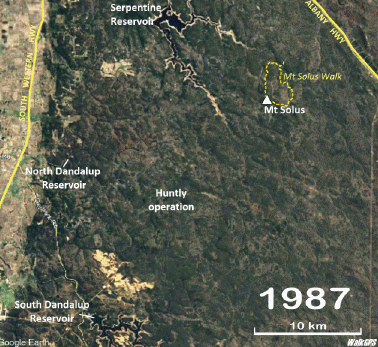
Time lapse images Click to view larger map.
ALCOA mining expansions
In late 2016 ALCOA announced its plans to start exporting unprocessed bauxite to China, bypassing its existing refineries near Perth and greatly accelerating the rate of removal of mature forest for the mining. For ALCOA’s Huntly operation alone, the gross area so far affected is over 600 sq km and the gross mining footprint is now expanding at a rate of over 3000ha a year around the Mount Solus area (see time lapse image for 1987-2016 period). In 2020 ALCOA proposed a major expansion of mining around the Huntly area (see map) which would increase the gross mining envelope between Jarrahdale and Dwellingup to around 900 sq km. The proposal will be subject to a Public Environmental Review.
Environmental impacts
“Sustainable bauxite mining” is an oxymoron.
Impacts on forest and landscape – The extraordinary accelerated rate of expansion is surely outstripping the forest’s ability to eventually recover. Despite the miners’ claims of globally unparalleled excellence in rehabilitation of mined native forest areas, huge areas of mature forest habitat on Perth’s doorstep are being lost. The degraded landscape is quickly and cosmetically re-greened by the miners, but independent experts are increasingly sceptical about the miners’ assurances that this young replacement forest will thrive in the longer term. (ref. “Undermined”).
Only about 15% of the land area within ALCOA’s 7000 sq km lease is protected within existing or proposed national parks and Lane Poole Reserve; most of the remaining 85% (~5900 sq km) will eventually be directly mined or otherwise impacted and fragmented by mining. Alcoa has previously claimed that “over an expected 100-year or so life of the viable bauxite reserves, [the company] will have disturbed [only] 5.6% of the northern jarrah forest”. Today satellite imagery across the Huntly operation reveals that the actual disturbance is much greater and is increasing at an unprecedented rate. Before mining is completed more than 60% of the mature northern jarrah forest and wandoo woodlands close to Perth will have been cleared or fragmented by mining and will include extensive areas of ‘rehabilitated’ former minesites. HikeWest (formerly ‘Bushwalking WA’), as the peak body for bushwalking in the State, in a March 2018 submission to a national senate inquiry into minesite rehabilitation has noted that walkers will in the future avoid the rehabilitated minesite areas as the severely altered condition of the landscape and vegetation is unsuitable for enjoyable bushwalking.
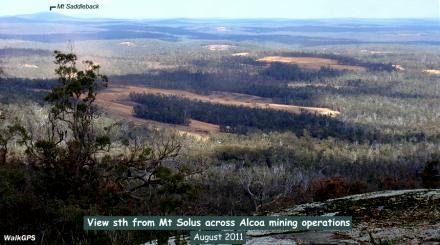 Impact on water resources – In a 2007 article “Bauxite Mining in Jarrah Forests” Roger Underwood, a former General Manager of W.A. Department of Conservation and Land Management (CALM), noted that “Apart from the loss of native forest, there has been a significant loss of run-off into streams and dams in the mined-over catchment areas. Pits have been designed to retain rather than shed rainfall, so run-off to forest streams is close to zero, and in many cases old mine pits cover nearly 50% of each sub-catchment. This has obvious impacts on water resources and aquatic ecosystems.”
Impact on water resources – In a 2007 article “Bauxite Mining in Jarrah Forests” Roger Underwood, a former General Manager of W.A. Department of Conservation and Land Management (CALM), noted that “Apart from the loss of native forest, there has been a significant loss of run-off into streams and dams in the mined-over catchment areas. Pits have been designed to retain rather than shed rainfall, so run-off to forest streams is close to zero, and in many cases old mine pits cover nearly 50% of each sub-catchment. This has obvious impacts on water resources and aquatic ecosystems.”
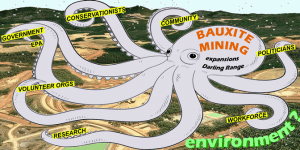 CSIRO has measured the substantial decreases in water yield from mined catchment areas. The cost to the State to boost desalination to replace this loss in drinking water availability is now likely to annually exceed the royalties paid to the State by the miners (for details see F. Batini, FIFA, 2016). But the DoW in its published Plans of 2007 was more concerned with the impact of bushwalkers than with bauxite miners: Its “Mundaring Weir Catchment Area Drinking Water Source Protection Plan” considered perceived risks of bushwalking and camping activities on water quality but made no mention of the substantial impact planned future mining will have within that same catchment and its risks for water run-off. The DoW’s “Canning River Catchment…Plan” noted only that “bauxite mining does not currently occur in the catchment” but will be “acceptable if operated in compliance with conditions…”.
CSIRO has measured the substantial decreases in water yield from mined catchment areas. The cost to the State to boost desalination to replace this loss in drinking water availability is now likely to annually exceed the royalties paid to the State by the miners (for details see F. Batini, FIFA, 2016). But the DoW in its published Plans of 2007 was more concerned with the impact of bushwalkers than with bauxite miners: Its “Mundaring Weir Catchment Area Drinking Water Source Protection Plan” considered perceived risks of bushwalking and camping activities on water quality but made no mention of the substantial impact planned future mining will have within that same catchment and its risks for water run-off. The DoW’s “Canning River Catchment…Plan” noted only that “bauxite mining does not currently occur in the catchment” but will be “acceptable if operated in compliance with conditions…”.
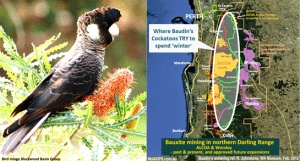 Deficiencies of old State Agreements – A Federal senate inquiry on mine rehabilitation in WA in March 2018 revealed that the state agreements that companies such as Alcoa operate under in WA result in contradictory situations in environmental planning, and in some cases override federal environmental controls. An environmental asset such as aged forest within the Alcoa lease, providing nesting hollows for endangered black cockatoos, took hundreds of years to develop. Yet Alcoa is able to remove potential black cockatoo habitat without recourse to the federal act applying to companies not operating under state agreement acts. The inquiry noted that Alcoa could not restore aged forest – the prime habitat for black cockatoos. (See article “Mine rehab in WA is the pits..” , Young, 2018.)
Deficiencies of old State Agreements – A Federal senate inquiry on mine rehabilitation in WA in March 2018 revealed that the state agreements that companies such as Alcoa operate under in WA result in contradictory situations in environmental planning, and in some cases override federal environmental controls. An environmental asset such as aged forest within the Alcoa lease, providing nesting hollows for endangered black cockatoos, took hundreds of years to develop. Yet Alcoa is able to remove potential black cockatoo habitat without recourse to the federal act applying to companies not operating under state agreement acts. The inquiry noted that Alcoa could not restore aged forest – the prime habitat for black cockatoos. (See article “Mine rehab in WA is the pits..” , Young, 2018.)
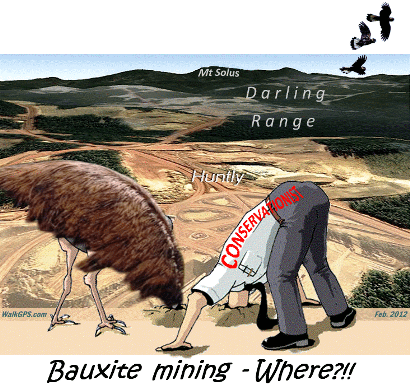 Public awareness
Public awareness
The general public is not informed as to what is happening to the Darling Range and the consequences for future generations. The battle to stop expansions of the strip-mining was lost by conservationists back in the early 1980’s. The Campaign to Save Native Forests continued to fight for conservation of our forests; the impacts of mining were no longer a focus but CSNF publications such as “Forests on Foot – 40 walks…” (Meney & Brown 1985) encouraged continuing public awareness and connection to our forests. But today the conservationists are strangely silent on the mining expansions and – in the absence of information – the community is at present largely disinterested. That will change if expanding exports of bauxite lead to refinery cut-backs and massive local job losses.
Consultation?
The State forests affected by the mining have multiple uses. Recreational bushwalking is one legitimate use. The miners are required to submit updated mining plans annually for approval to a multi-agency liaison group (‘MMPLG’) so that the activities of other forest users can be integrated. But this group has no community representation or public accountability; And the miners’ community consultation processes focus on ‘local’ communities, bypassing the broader community including bushwalkers. The miners’ claimed “social licence to operate” cannot be legitimate in the absence of transparency and proper consultation with the wider community on the impacts of the current rate of mining expansion and the export of unprocessed bauxite.
What to do?
In the face of such obstacles, the bushwalking community needs to find its own ways to keep itself more informed and aware of the impacts of the mining expansions on popular walk areas. We should also attempt to achieve at least the following:
- forest roads giving access to our walk areas are kept open;
- mining plans retain attractive breakaway landscape plus sizeable pockets of original forest wherever possible;
- vegetation buffers are preserved to screen operations from adjacent bushwalking areas ; and
- blasting noise and dust emissions from sites close to walk areas are minimised.
One local community’s response
The Dwellingup Community in late 2017 released a position statement and local action plan on the best way to protect Dwellingup from the detrimental impacts of bauxite mining, including particularly, conservation biodiversity, landscape amenity loss and the resulting loss of Dwellingup’s capacity to attract visitors. The community proposed a Bauxite Mining Exclusion Zone (“Dwellingup Discovery Forest”) to protect Dwellingup values for nature tourism including the Murray Shire’s “National Adventure and Trails Centre” project. The position statement also listed several of the community’s concerns, including in part (in summary):
- lack of engagement of the miner (Alcoa) and State Government with the local community in problem resolution;
- lack of State Government policies to protect multiple-use forest management values including traditional recreation;
- encouragement of miners (under State Agreements) to provide donated funding aimed at meeting company – as distinct from community – objectives;
- lack of recognition of difference between multiple-use forest management values and non-renewable resource extraction and the irreversible changes to biodiversity, landscape and unique soil profiles.
The legacy
Future generations may well ask in dismay how any growing city could have allowed a once extensive mature and unique forest right on its doorstep to be so plundered and degraded. As Roger Underwood, also said in his 2007 article:
“One of the most interesting anomalies in Australian environmentalism is that the alumina industry is destroying the jarrah forest – and nobody seems to care. At least, nobody is complaining.” “…..there will come a time in the not-too-distant future when West Australians realise what has gone on, and the extent and cost of the ecological damage which has occurred. Then perhaps they will look back on the …. destruction of the jarrah forest by bauxite mining as one of the greatest conservation blunders in our history.”
“Bannister Hill – once was a Conservation Park” – WalkGPS video.
(length = 3:59 minutes)
Alternatively: Click here to view the video on Vimeo.
Additional information
“A thousand cuts – Mining in the Northern Jarrah Forests” – report by Project NJF (WA Forest Alliance, Wilderness Society, CCWA), 2022.
“Alcoa proposed Myara North and Holyoake mining expansions, mining leases, and Bibbulmun Track overlaid on DBCA map of mine clearing and ‘rehabilitation” – courtesy WalkGPS (after DBCA Parks & Wildlife), Aug. 2021.
“Bauxite mining” – HikeWest (WA’s peak hiking / bushwalking body) – web page.
“Changing the Mt Solus landscape” – WalkGPS video.
“Disappearing wandoo woodlands & laterite breakaways” – WalkGPS video.
Dwellingup Discovery Forest – The Dwellingup Protection Group (a sub-committee of Dwellingup Community Compact).
“Fighting for the Forests – A history of the Western Australian forest protest movement 1895-2001” – Ron Chapman doctoral thesis, 2008. (Murdoch University Research Repository).
“Impact of bauxite mining on water yield” – F. Batini FIFA (from “Managing forested catchments – threats and opportunities”, Institute of Foresters Australia workshop, 2016). Presentation.
“Last chance: New WA plan will profoundly impact our jarrah forests” – Dave Osborne, President, HikeWest, WA Today, 12 Dec. 2022.
“Mine rehab in WA is the pits: Inquiry finds few success stories” – Emma Young article, WA Today, 9 Mar. 2018.
“Mostly out of sight and mined?” – Dave Osborne article, Aug. 2013. (Shorter version was published in “Wild” magazine, issue #138, Nov.-Dec. 2013, as “Bauxite vs bushwalking”.)
“Save our Jarrah” – Jarrahdale Forest Protectors.
“Statement on Bauxite Mining and Revegetation in the Northern Jarrah Forest” – Forestry Australia, February 2022.
“The “Thousand Cuts” report – bauxite mining’s #1 role in deforestation in Western Australia” – HikeWest (WA’s peak bushwalking body) – website post, 8 May 2022.
“To run or tread water on national parks” – HikeWest (WA’s peak hiking / bushwalking body) – web post.
“To what extent can mine rehabilitation restore recreational use of forest land? Learning from 50 years of practice in southwest Australia” – J.C.S. Rosa et al, scientific paper, Jan. 2020.
“The McGowan logic – sustainable native forest logging not environmentally acceptable, but widespread clearing of jarrah forest for bauxite is” – Robert Onfray, article in Australian Rural & Regional News, 6 May 2022.
“Undermined” – Victoria Laurie, article in The Weekend Australian Magazine, 13-14 August, p.22-25. Accessible via subscription only.
“What future for WA’s northern jarrah forest?” – Dave Osborne, Dec. 2021. (Online version of article published in “Wild” magazine, issue #182, Summer 2021.)
“What’s going on in the jarrah forest?” – Jack Bradshaw, Dec. 2021. (YouTube video; 4.5 min).
“Worsley Alumina Project Expansion- Environmental Review and Management Programme –Executive Summary” – Strategen for Worsley Alumina Pty Ltd, May 2005.


